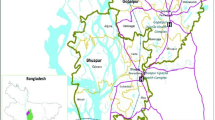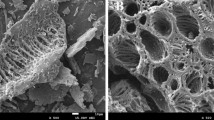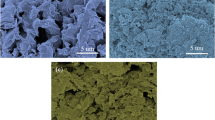Abstract
Immobilization using biochar is a cost-effective and environmentally friendly remediation method to inhibit the transfer of soil contaminants to the food chain. This study evaluated the effects of coconut shell–derived biochar (CSB) and sewage sludge–derived biochar (SSB) on reducing the accumulation of cesium (Cs) by plant from contaminated soil. Pot experiment was conducted by cultivating Napier grass on the soil added with different Cs concentrations (0, 25, and 50 mg kg−1) and biochar ratios (0: control, 5% and 10%). It was observed that both biochars significantly restricted the transfer of Cs to the root, leaf sheath, and leaf blade of Napier grass (p < 0.01). The possible mechanisms of Cs immobilization by biochar could be the sorption of Cs on the surface of biochar as well as the restriction of the uptake of Cs by plant due to the increased K concentration of biochar-amended soil. CSB application was more effective than SSB on reducing the transfer of Cs to plant. Compared to control, the CSB application reduced the concentration of Cs in the plant by 80.2–98.2%. Moreover, obtained results in terms of pH, organic matter content, cation exchange capacity, specific surface area, and K concentration of biochar-amended soil highlighted the remarkable efficiency of CSB to adsorb Cs and restrict Cs transfer to plant providing the key evidences for Cs immobilization. Considering these results, CSB could be a potential amendment for the immobilization of Cs-contaminated soil.





Similar content being viewed by others
Data Availability
The datasets used or analyzed during this study are available on reasonable request.
References
Ban-Nai, T., Murmatsu, Y., & Yanagisawa, K. (1999). Transfer of some selected radionuclides (Cs, Sr, Mn, Co, Zn and Ce) from soil to root vegetables. Journal of Radioanalytical and Nuclear Chemistry, 241, 529–531.
Beesley, L., Moreno-Jiménez, E., Gomez-Eyles, J. L., Harris, E., Robinson, B., & Sizmur, T. (2011). A review of biochars’ potential role in the remediation, revegetation and restoration of contaminated soils. Environmental Pollution, 159, 3269–3282.
Burger, A., & Lichtscheidl, I. (2018). Stable and radioactive cesium: a review about distribution in the environment, uptake and translocation in plants, plant reactions and plants' potential for bioremediation. Sci. Total Environ., 618, 1459–1485.
Cao, X. D., Ma, L. N., Liang, Y., Gao, B., & Harris, W. (2011). Simultaneous immobilization of lead and atrazine in contaminated soils using dairy-manure biochar. Environmental Science & Technology, 45, 4884–4889.
Cook, L. L., Inouye, R. S., McGonigle, T. P., & White, G. J. (2007). The distribution of stable cesium in soils and plants of the eastern Snake River Plain in southern Idaho. Journal of Arid Environments, 69, 40–64.
Cook, L. L., Inouye, R. S., & McGonigle, T. P. (2009). Evaluation of four grasses for use in phytoremediation of Cs-contaminated arid land soil. Plant and Soil, 324, 169–184.
Ding, D., Zhang, Z., Lei, Z., Yang, Y., & Cai, T. (2016). Remediation of radiocesium-contaminated liquid waste, soil, and ash: a mini review since the Fukushima Daiichi nuclear power plant accident. Environmental Science and Pollution Research, 23(3), 2249–2263.
Durrant, C. B., Begg, J. D., Kersting, A. B., & Zavarin, M. (2018). Cesium sorption reversibility and kinetics on illite, montmorillonite, and kaolinite. Sci. Total Environ., 610, 511–520.
Figueiredo, C. C., Chagas, J. K. M., Silva, J., & Paz-Ferreiro, J. (2019). Short-term effects of a sewage sludge biochar amendment on total and available heavy metal content of a tropical soil. Geoderma, 344, 31–39.
Fujimura, S., Muramatsu, Y., Ohno, T., Saitou, M., Suzuki, Y., Kobayashi, T., Yoshioka, K., & Ueda, Y. (2015). Accumulation of 137Cs by rice grown in four types of soil contaminated by the Fukushima Dai-ichi Nuclear Power Plant accident in 2011 and 2012. Journal of Environmental Radioactivity, 140, 59–64.
Fujiwara, T. (2014). Cesium uptake in rice: possible transporter, distribution, and variation. Japan: Springer.
Gadepalle, V. P., Ouki, S. K., Herwijnen, R. V., & Hutchings, T. (2007). Immobilization of heavy metals in soil using natural and waste materials for plant establishment on contaminated sites. Soil and Sediment Contamination, 16(2), 233–251.
Gee, G.W., Bauder, J.W. (1986). Particle size analysis. In: Klute, A. (Ed.), Methods of Soil Analysis, 383–399. Part 1, second ed., agronomy.
Guillén, J., Baeza, A., Salas, A., Muñoz-Muñoz, J.G., Muñoz-Serrano, A. (2017). Factors influencing the soil to plant transfer of radiocaesium. In Impact of Cesium on Plants and the Environment, 19–33. Springer International Publishing.
Hamid, Y., Tang, L., Hussain, B., Usman, M., Gurajala, H. K., Rashid, M. S., He, Z., & Yang, X. (2020). Efficiency of lime, biochar, Fe containing biochar and composite amendments for Cd and Pb immobilization in a co-contaminated alluvial soil. Environmental Pollution, 257, 113609.
Hamilton, T. F., Martinelli, R. E., Kehl, S. R., Hayes, M. H. B., Smith, I. J., Peters, S. K. G., Tamblin, M. W., Schmitt, C. L., & Hawk, D. (2016). A preliminary assessment on the use of biochar as a soil additive for reducing soil-to-plant uptake of cesium isotopes in radioactively contaminated environments. Journal of Radioanalytical and Nuclear Chemistry, 307(3), 2015–2020.
Huang, H. J., Yang, T., Lai, F. Y., & Wu, G. Q. (2017). Co-pyrolysis of sewage sludge and sawdust/rice straw for the production of biochar. Journal of Analytical and Applied Pyrolysis, 125, 61–68.
Hwang, T., & Neculita, C. M. (2013). In situ immobilization of heavy metals in severely weathered tailings amended with food waste-based compost and zeolite. Water, Air, and Soil Pollution, 224, 1388.
IAEA (2009). Quantification of radionuclide transfer in terrestrial and freshwater environments for radiological assessments. IAEA-TECDOC-1616, Vienna, Austria, 139–206, 261–263.
IAEA (International Atomic Energy Agency) (2006). Classification of soil systems on the basis of transfer factors of radionuclides from soil to reference plants. IAEA-TECDOC-1497. In: Proc, Chania, Crete, 22–26.
Jia, Z., Deng, J., Chen, N., Shi, W., Tang, X., & Xu, H. (2016). Bioremediation of cadmium-dichlorophen co-contaminated soil by spent Lentinus edodes substrate and its effects on microbial activity and biochemical properties of soil. Journal of Soils and Sediments, 17, 1–11.
Jiang, T. Y., Jiang, J., Xu, R. K., & Li, Z. (2012). Adsorption of Pb (II) on variable charge soils amended with rice-straw derived biochar. Chemosphere, 89, 249–256.
Kang, D. J., Seo, Y.-J., Saito, T., Suzuki, H., & Ishii, Y. (2012). Uptake and translocation of cesium-133 in Napier grass (Pennisetum purpureum Schum.) under hydroponic conditions. Ecotoxicology and Environmental Safety, 82, 122–126.
Koarashi, J., Atarashi-Andoh, M., Matsunaga, T., Sato, T., Nagao, S., & Nagai, H. (2012). Factors affecting vertical distribution of Fukushima accident-derived radiocesium in soil under different land-use conditions. Science of the Total Environment, 431, 392–401.
Kondo, M., Makino, T., Eguchi, T., Goto, A., Nakano, H., & Takai, T. (2015). Comparative analysis of the relationship between Cs and K in soil and plant parts toward control of Cs accumulation in rice. Soil Science & Plant Nutrition, 61, 144–151.
Lahori, A. H., Guo, Z., Zhang, Z., Li, R., Mahar, A., Awasthi, M. K., Shen, F., Sial, T. A., Kumbhar, F., Wang, P., & Jiang, S. (2017). Use of biochar as an amendment for remediation of heavy metal-contaminated soils: prospects and challenges. Pedosphere, 27(6), 991–1014.
Lai, J. L., Fu, Q., Tao, Z. Y., Lu, H., & Luo, X. G. (2016). Analysis of the accumulation and redistribution patterns of cesium in Vicia faba grown on contaminated soils. Journal of Environmental Radioactivity, 164, 202–208.
Lee, S. H., Lee, J. S., Choi, Y. J., & Kim, J. G. (2009). In situ stabilization of cadmium-, lead-, and zinc-contaminated soil using various amendments. Chemosphere, 77, 1069–1075.
Liu, X., Chen, G. R., Lee, D. J., Kawamoto, T., Tanaka, H., Chen, M. L., & Luo, Y. K. (2014). Adsorption removal of cesium from drinking waters: a mini review on use of biosorbents and other adsorbents. Bioresource Technology, 160, 142–149.
Liu, K., Lv, J., He, W., Zhang, H., Cao, Y., & Dai, Y. (2015). Major factors influencing cadmium uptake from the soil into wheat plants. Ecotoxicology and Environmental Safety, 113, 207–213.
Liu, H., Xu, F., Xie, Y., Wang, C., Zhang, A., Li, L., & Xu, H. (2018). Effect of modified coconut shell biochar on availability of heavy metals and biochemical characteristics of soil in multiple heavy metals contaminated soil. Sci. Total Environ., 645, 702–709.
Matsunaga, T., Koarashi, J., Atarashi-Andoh, M., Nagao, S., Sato, T., & Nagai, H. (2013). Comparison of the vertical distributions of Fukushima nuclear accident radiocesium in soil before and after the first rainy season, with physicochemical and mineralogical interpretations. Sci. Total Environ., 447, 301–314.
Nakao, A., Thiry, Y., Funakawa, S., & Kosaki, T. (2008). Characterization of the frayed edge site of micaceous minerals in soil clays influenced by different pedogenetic conditions in Japan and northern Thailand. Soil Science & Plant Nutrition, 54, 479–489.
Navarrete-López, M., Jonathan, M. P., Rodríguez-Espinosa, P. F., & Salgado-Galeana, J. A. (2012). Autoclave decomposition method for metals in soils and sediments. Environmental Monitoring and Assessment, 184(4), 2285–2293.
Nikitin, A.N., Shurankova, O.A., Popova, O.I.I., Cheshyk, I.A.E., Spirov, R.K. (2019). Potential of biochar as a measure for decreasing bioavailability of 137Cs in soil. In Remediation measures for radioactively contaminated areas. Springer, Cham. 113–137.
Ogura, S. I., Suzuki, T., & Saito, M. (2014). Distribution of radioactive cesium in soil and its uptake by herbaceous plants in temperate pastures with different management after the Fukushima Dai-Ichi Nuclear Power Station accident. Soil Science & Plant Nutrition, 60(6), 790–800.
Parajuli, D., Kitajima, A., Takahashi, A., Tanaka, H., Ogawa, H., Hakuta, Y., Yoshino, K., Funahashi, T., Yamaguchi, M., Osada, M., & Kawamoto, T. (2016). Application of Prussian blue nanoparticles for the radioactive Cs decontamination in Fukushima region. Journal of Environmental Radioactivity, 151, 233–237.
Rigol, A., Vidal, M., & Rauret, G. (2002). An overview of the effect of organic matter on soil-radiocaesium interaction: implications in root uptake. Journal of Environmental Radioactivity, 58, 191–216.
Rinaldi, F., Komínková, D., Berchová, K., Daguenet, J., & Pecharová, E. (2017). Stable cesium (133Cs) uptake by Calla palustris from different substrates. Ecotoxicology and Environmental Safety, 139, 301–307.
Ruan, X., Sun, Y., Du, W., Tang, Y., Liu, Q., Zhang, Z., Doherty, W., Frost, R. L., Qian, G., & Tsang, D. C. W. (2019). Formation, characteristics, and applications of environmentally persistent free radicals in biochars: a review. Bioresource Technology, 281, 457–468.
Sawai, H., Rahman, I. M. M., Lu, C., Tsukagoshi, Y., Begum, Z. A., Maki, T., & Hasegawa, H. (2015). Temporal variations of accumulated cesium in natural soils after an uncharacteristic external exposure. Microchemical Journal, 118, 158–165.
Schollenberger, C. J., & Simon, R. H. (1945). Determination of exchange capacity and exchangeable bases in soils. Soil Science, 59, 13–25.
Shao, H., Wei, Y., & Li, F. (2019). Fixation capability of recycling materials as potential additives for cesium immobilization in contaminated forest soil. Journal of Radioanalytical and Nuclear Chemistry, 319(1), 315–326.
Smolders, E., & Tsukada, H. (2011). The transfer of radiocesium from soil to plants: mechanisms, data, and perspectives for potential countermeasures in Japan. Integrated Environmental Assessment and Management, 7, 379–381.
Spokas, K. A. (2010). Review of the stability of biochar in soils: predictability of O:C molar ratios. Carbon Management, 1, 289–303.
Sun, Y., Xu, Y., Xu, Y., Wang, L., Liang, X., & Li, Y. (2016). Reliability and stability of immobilization remediation of Cd polluted soils using sepiolite under pot and field trials. Environmental Pollution, 208, 739–746.
Teramage, M. T., Onda, Y., Patin, J., Kato, H., Gomi, T., & Nam, S. (2014). Vertical distribution of radiocesium in coniferous forest soil after the Fukushima nuclear power plant accident. Journal of Environmental Radioactivity, 137, 37–45.
Tica, D., Udovic, M., & Lestan, D. (2011). Immobilization of potentially toxic metals using different soil amendments. Chemosphere, 85, 577–583.
Uchimiya, M., Klasson, K. T., Wartelle, L. H., & Lima, I. M. (2011). Influence of soil properties on heavy metal sequestration by biochar amendment. 1. Copper sorption isotherms and the release of cations. Chemosphere, 82, 1431–1437.
Wakabayashi, S., Itoh, S., Kihou, N., Matsunami, H., Hachinohe, M., Hamamatsu, S., & Takahashi, S. (2016). Influence of water management and fertilizer application on 137Cs and 133Cs uptake in paddy rice fields. Journal of Environmental Radioactivity, 157, 102–112.
Wang, C. J., Lai, S. Y., Wang, J. J., & Lin, Y. M. (1997). Transfer of radionuclides from soil to grass in northern Taiwan. Applied Radiation and Isotopes, 48, 301–303.
Wang, Q., Wang, B., Lee, X., Lehmann, J., & Gao, B. (2018). Sorption and desorption of Pb (II) to biochar as affected by oxidation and pH. Science of the Total Environment, 634, 188–194.
White, P. J., & Broadley, M. R. (2000). Tansley review no. 113 mechanisms of caesium uptake by plants. The New Phytologist, 147(2), 241–256.
Wu, P., Cui, P. X., Fang, G. D., Wang, Y., Wang, S. Q., Zhou, D. M., Zhang, W., & Wang, Y. J. (2018). Biochar decreased the bioavailability of Zn to rice and wheat grains: Insights from microscopic to macroscopic scales. Science of the Total Environment, 621, 160–167.
Xie, T., Reddy, K. R., Wang, C., Yargicoglu, E., & Spokas, K. (2015). Characteristics and applications of biochar for environmental remediation: a review. Critical Reviews in Environmental Science and Technology, 45(9), 939–969.
Yaashikaa, P. R., Senthil Kumar, P., Varjani, S. J., & Saravanan, A. (2019). Advances in production and application of biochar from lignocellulosic feedstocks for remediation of environmental pollutants. Bioresource Technology, 292, 122030.
Yoshida, S., Muramatsu, Y., Dvornik, A., Znuchenko, T., & Linkov, I. (2004). Equilibrium of radiocesium with stable cesium within biological cycle of contaminated forest systems. Journal of Environmental Radioactivity, 75, 301–313.
Zhu, Y. G., & Smolders, E. (2000). Plant uptake of radiocaesium: a review of mechanisms, regulation and application. Journal of Experimental Botany, 51(351), 1635–1645.
Funding
This work was supported by Japan Society for the Promotion of Science (JSPS) (KAKENHI Grant Number: 18K11694).
Author information
Authors and Affiliations
Contributions
Huijuan Shao: investigation, data curation, writing, and editing. Yongfen Wei: supervision, review, and editing. Fuping Zhang: review and editing. Fusheng Li: conceptualization, resources, review, and editing.
Corresponding author
Ethics declarations
Conflict of Interest
The authors declare that they have no competing interests.
Code Availability
Not applicable.
Additional information
Publisher’s Note
Springer Nature remains neutral with regard to jurisdictional claims in published maps and institutional affiliations.
Rights and permissions
About this article
Cite this article
Shao, H., Wei, Y., Zhang, F. et al. Effects of Biochars Produced from Coconut Shell and Sewage Sludge on Reducing the Uptake of Cesium by Plant from Contaminated Soil. Water Air Soil Pollut 231, 550 (2020). https://doi.org/10.1007/s11270-020-04922-2
Received:
Accepted:
Published:
DOI: https://doi.org/10.1007/s11270-020-04922-2




